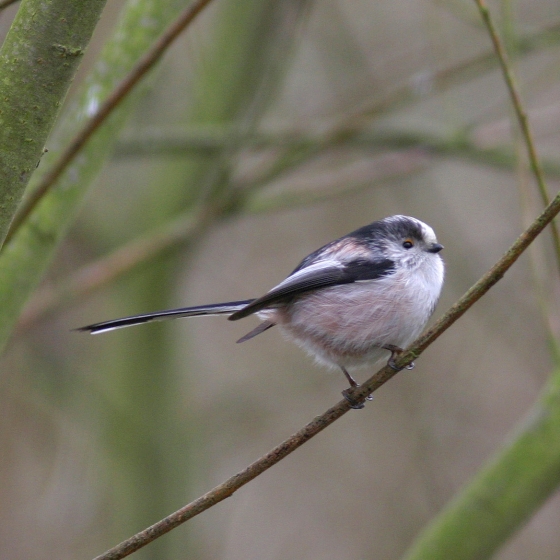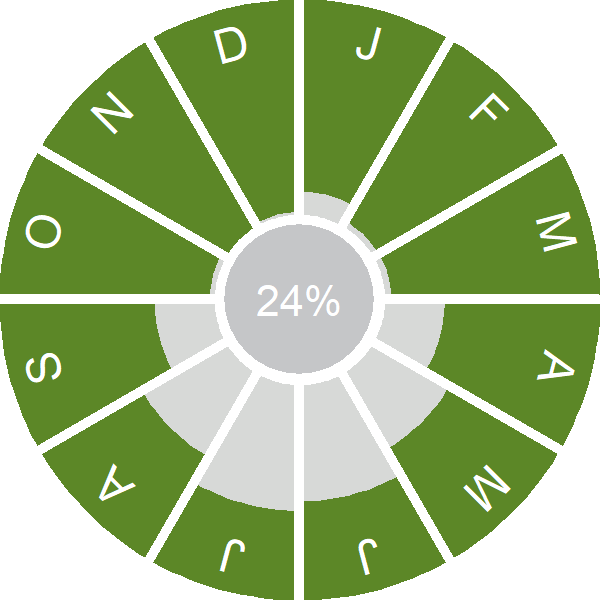Long-tailed Tit
Aegithalos caudatus (Linnaeus, 1758)
LT
 LOTTI
LOTTI  14370
14370

Family: Passeriformes > Aegithalidae

This small, sociable species can be found year round throughout Britain & Ireland, apart from on the highest peaks and farthest flung Scottish islands.
Long-tailed Tits live up to their name, with tails that are noticeably longer than their bodies. They have pale underparts contrasting with darker wings and tail, distinctive black stripes on an otherwise white head, and blush pink on the breast, wings and eye-ring. Long-tailed Tits typically lay a single clutch of eggs in March and April in a beautifully intricate domed nest, constructed of lichen and cobwebs, and lined with up to 1,500 feathers. This species has a co-operative breeding strategy, with younger birds helping breeding pairs to rear chicks. Males and females look alike.
Being small, Long-tailed Tits are susceptible to harsh weather, and as a result, their numbers fluctuate. However, it is on the Green List in both the UK and Ireland. The species favours woodland habitats, but is also found in hedgerows, parks and gardens. Birds often move in extended family groups and can be heard calling to each other and they flutter from perch to perch. In winter, they will form flocks with other small species.
Exploring the trends for Long-tailed Tit
Our Trends Explorer will also give you the latest insight into how the UK's Long-tailed Tit population is changing.
trends explorerIdentification
Long-tailed Tit identification is usually straightforward.
SONGS AND CALLS
Listen to example recordings of the main vocalisations of Long-tailed Tit, provided by xeno-canto contributors.
Begging call
Call
Develop your bird ID skills with our training courses
Our interactive online courses are a great way to develop your bird identification skills, whether you're new to the hobby or a competent birder looking to hone your abilities.
Browse training coursesStatus and Trends
Population size and trends and patterns of distribution based on BTO surveys and atlases with data collected by BTO volunteers.
CONSERVATION STATUS
This species can be found on the following statutory and conservation listings and schedules.
POPULATION CHANGE
The starting years of the long-term monitoring periods coincides with a trough in population, thus exaggerating the long-term trend. CBC/BBS index trends show progressive increases in Long-tailed Tit abundance beginning in the early 1980s. The BBS map of change in relative density between 1994-96 and 2007-09 indicates that increase occurred almost throughout the UK range over that period, most strongly in northern England. Numbers across Europe have been broadly stable since 1980 (PECBMS: PECBMS 2020a>).
| UK breeding population |
+15% increase (1995–2022) 
|
Exploring the trends for Long-tailed Tit
Our Trends Explorer will also give you the latest insight into how the UK's Long-tailed Tit population is changing.
trends explorerDISTRIBUTION
Long-tailed Tits are widespread in Britain & Ireland, occupying 83% of 10-km squares in winter and 78% in the breeding season. The only gaps in range occur on upland moors in mainland Scotland, on the Outer Hebrides and Northern Isles, and in central and western Ireland. Densities are highest in wooded lowland areas of Britain and Ireland.
Occupied 10-km squares in UK
| No. occupied in breeding season | 2397 |
| % occupied in breeding season | 79 |
| No. occupied in winter | 2554 |
| % occupied in winter | 85 |
European Distribution Map
European Breeding Bird Atlas 2
Breeding Season Habitats
| Most frequent in |
Deciduous Wood 
|
| Also common in | Scrub |
Relative frequency by habitat
Relative occurrence in different habitat types during the breeding season.

DISTRIBUTION CHANGE
Long-tailed Tits are particularly vulnerable to cold weather, and the 22% winter range expansion since the 1981–84 Winter Atlas could reflect an increase in numbers, with birds spreading farther into upland marginal areas following a series of mild winters.
Change in occupied 10-km squares in the UK
| % change in range in breeding season (1968–72 to 2008–11) | +2.6% |
| % change in range in winter (1981–84 to 2007–11) | +15.1% |
SEASONALITY
Long-tailed Tit is recorded throughout the year, more so outside the breeding season when large mobile and noisy flocks are easily detected.

Movement
Information about movement and migration based on online bird portals (e.g. BirdTrack), Ringing schemes and tracking studies.
RINGING RECOVERIES
View a summary of recoveries in the Online Ringing Report.
Foreign locations of birds ringed or recovered in Britain & Ireland

Biology
Lifecycle and body size information about Long-tailed Tit, including statistics on nesting, eggs and lifespan based on BTO ringing and nest recording data.
PRODUCTIVITY & NESTING
Exploring the trends for Long-tailed Tit
Our Trends Explorer will also give you the latest insight into how the UK's Long-tailed Tit population is changing.
trends explorerSURVIVAL & LONGEVITY
View number ringed each year in the Online Ringing Report
Maximum Age from Ringing 
|
8 years 11 months 0 days (set in 2014) 
|
Typical Lifespan 
|
2 years with breeding typically at 1 year |
Adult Survival 
|
0.443±0.044  
|
Juvenile Survival 
|
0.251 (in first year) 
|
Exploring the trends for Long-tailed Tit
Our Trends Explorer will also give you the latest insight into how the UK's Long-tailed Tit population is changing.
trends explorerBIOMETRICS
Wing Length 
|
Adults | 60.9±1.6 | Range 58–64mm, N=12498 |
| Juveniles | 59.2±2.3 | Range 56-63mm, N=1784 | |
| Males | 61.8±1.5 | Range 60–64mm, N=961 | |
| Females | 60.1±1.6 | Range 58–63mm, N=1668 |
Body Weight 
|
Adults | 7.80±0.6 | Range 7.00–8.70g, N=9928 |
| Juveniles | 7.90±0.5 | Range 7.10–8.80g, N=1133 | |
| Males | 7.90±0.5 | Range 7.20–8.70g, N=730 | |
| Females | 8.00±0.7 | Range 7.10–9.30g, N=1340 |
Feather measurements and photos on featherbase 
CODES & CLASSIFICATION
Ring size 
|
AA |
Field Codes 
|
2-letter: LT | 5-letter code: LOTTI | Euring: 14370 |
For information in another language (where available) click on a linked name
Research
Interpretation and scientific publications about Long-tailed Tit from BTO scientists.
CAUSES AND SOLUTIONS
Causes of change
This species undergoes wide fluctuations in numbers between breeding seasons. Inter-annual variation in adult survival is driven by weather conditions; however spring and autumn weather may sometimes be more important than winter weather.
Further information on causes of change
This species undergoes wide fluctuations in numbers between breeding seasons, suffering heavy mortality in some years but able to recover quickly by virtue of its high breeding potential. Modelling suggests that climate change may have had a positive impact on the long-term trend for this species (Pearce-Higgins & Crick 2019). In an ongoing mark-recapture study near Sheffield, weather explained 73% of the inter-annual variation in adult survival during 1994-2012: warm springs and autumns increased survival, wet springs reduced survival but, during the period of study, winter weather had little effect (Gullett et al. 2014). The same study found that warm weather in March depressed recruitment in the following year, whereas warm May weather enhanced it (Gullett et al. 2015). Numbers across England were low after the severe winters of the early 1960s and again during a series of relatively cold winters beginning in the late 1970s, and fell slightly again after the cold winters around 2010, but winter mortality might not be the primary cause.
Clutches have become smaller since the 1960s and, curiously, nest losses have switched from the egg to the chick stage. There has been no overall trend in the number of fledglings per breeding attempt. The marked trend towards earlier laying may be explained by recent climatic changes (Crick & Sparks 1999).
Information about conservation actions
The population of this species has increased since the 1980s with minor fluctuations, hence it is not a species of concern and no conservation actions are currently required.
Research focused on this species is limited and hence few specific conservation actions have been proposed to help benefit Long-tailed Tits. A Finnish study found that long-tailed tits were most likely to be found in 1-km squares containing deciduous/mixed and alder forest (Jansson & Saari 1999). This suggests that planting patches of deciduous trees within coniferous forests could help long-tailed tits, although this action is of little relevance across most of the UK where suitable habitats already exist.
PUBLICATIONS (1)
Breeding season weather determines long-tailed tit reproductive success through impacts on recruitment
Links to more studies from ConservationEvidence.com
Would you like to search for another species?













Share this page